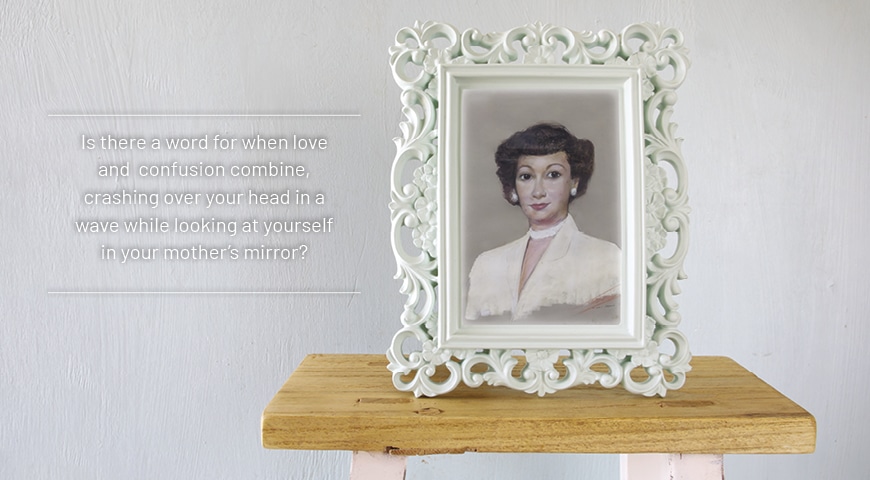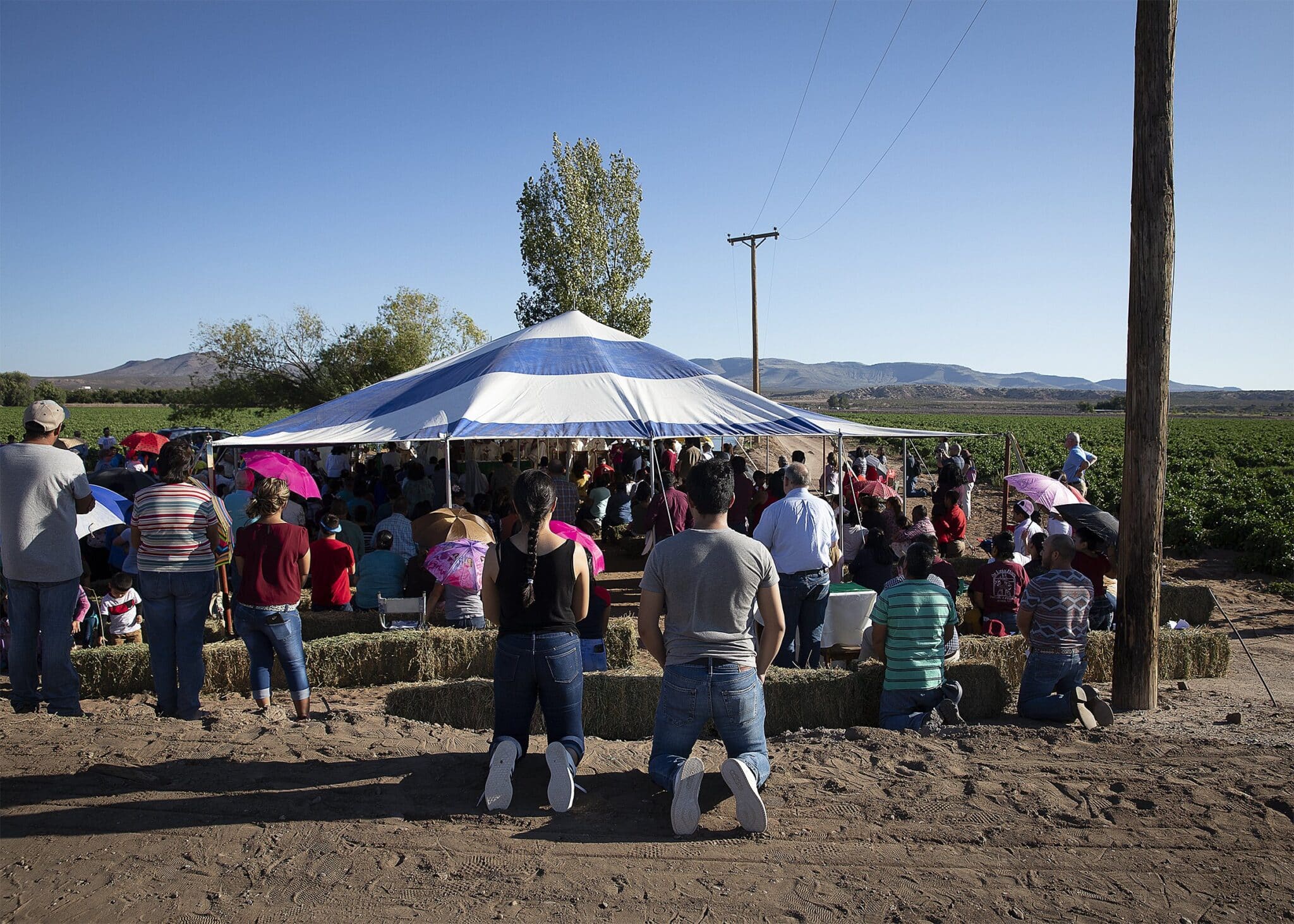The Lenten cross on her forehead reminds this author of the impermanence of our lives and the treasure that awaits us.
I’ve always loved Ash Wednesday, the ritual of the ashes themselves, the exact point of entering Lent with the priest’s thumb pressing a cross on my forehead. With the words “Remember that you are dust,” that first dark line is placed upon me with a silky flow. At the second line—“unto dust you shall return”—the ashes are already vanishing from his thumbprint and feel chalky. I expand with pride, witnessing all of us somberly wearing these holy marks, and, as we disperse back into our daily lives, I imagine the wind blowing upon us all and carrying these crosses away. Butx not completely—a hint always ends up on my own fingertips after touching my forehead, wondering if any of the dust has remained.
It’s from this faded imprint that I reflect now on a chalk portrait, and how these 40 days teach me so much about the themes of impermanence, forgiveness, and opening our hearts to the treasure.
Accepting Impermanence
As I head into Lent reflecting on this past year, I can’t deny so much has blown away: I joined family members in helping my 85-year-old mother move from her home of 30 years into a much smaller home. Those words look simple, but the sorrow was not. My mother’s dementia had taken over, and she required care 24/7. Because she was unable to participate in any aspect of this transition, we all threw ourselves, without her, into various tasks. One of mine was to prioritize thousands of objects, taking only what she needed and leaving much of her lifetime behind.
I was caught off guard by the entire process. I was confident that I knew how it all worked, this letting go, this impermanence. After all, I had gotten divorced eight years prior and had been faced with seeing the broken objects of a 25-year marriage overflow in a dumpster. I had been told then that the dumpster would be taken away on a Thursday, and when I pulled into the driveway after work on Wednesday night, it was gone. I was devastated to have all my brokenness gone a day early. It shocked me, how I had held on.
So as I plowed through my mother’s belongings, I felt I was seasoned. I wanted to believe I was tougher now after what I had been through, attacking my mother’s chaotic, overstuffed bureaus and closets with a ruthless frenzy. I was on a mission. She would remember nothing of any of the objects I held. We threw away bag after bag of junk. It’s not an exaggeration to say that while dragging a few of them out to the garbage bins, I heard her broken necklaces make the sound of sand falling within. It’s life, I told myself. Deal with it.
I persisted in my tough-guy phase, but after a weekend of this clearing out, the veneer began to crack. One of my next tasks was quite simple. In the bathroom of her new home, I opened a little vanity drawer and placed a full tube of toothpaste and her toothbrush inside. Into the drawer below it I tucked her comb. She’d once done this for my two siblings and me; I had done this for my own two children; now I was doing this for her.
Is there a word for when love and confusion combine, crashing over your head in a wave while looking at yourself in your mother’s mirror? Is there a word for when sorrow knocks over your mother in a wave?
Return with Your Whole Heart
In helping my mother move, I was given the opportunity to become a better listener, being present to my mother in her grief. This strengthening of my ability to listen has impacted my desire to listen more closely to Scripture. On Ash Wednesday, the words that are spoken as we receive our ashes are incredibly challenging and beautiful. But we also hear Scripture that adds layers to this day’s reflection. This year, I am grateful for Joel 2:12: “Return to me with your whole heart, with fasting, weeping, and mourning.”
The beginning of Lent is a return, and it does bring weeping and mourning. My family and I had been trying to navigate the move for Mom, to protect her and make it as easy as possible. We consulted with her neurologist’s social worker about how best to transition her. We did the entire move ourselves, without involving her, to try to minimize her anxiety and obsessing.
On the second night in her new house, she fully understood that she had moved. She had not been so certain, and now she knew. In 61 years of being her daughter, I’d never seen my mother cry that hard. Not when her mother, Irene, died, not when her “Pops” died, not when my father died. It came from a place that I do not think there’s a word for—though there should be.
“I just can’t believe it’s gone,” she sobbed. Her tears fell, turning amber in the lamplight. All I could think of was Psalm 56:9: “My wanderings you have noted; are my tears not stored in your flask?” These words had gotten me through the deepest grief of my divorce. I said very quietly: “I know, Mom. It’s hard. Change is hard.”
“It stinks,” she said bitterly.
In my head, I said Hail Marys. I sat on her four-poster bed, the one from her childhood, and she sobbed on her mother’s reupholstered loveseat. It was like this for hours, almost like watching rainfall. At night, when droplets cascade in a fury outside my house, the movement sets off the beams of the motion detector. The rain pours in the slant of the light. I felt God with us, so I did not try to talk her out of her feelings. She was right: It cut deep for things to disappear, for something as precious as a home to die. I knew I was being called to simply be alongside her.
“I know, Mom, it’s rough.”
“I can’t believe it’s gone. That was my home.”
It seemed to me I was in the womb at the center of the world, where a mother sobs for all that’s gone, all that has been taken, all that must be let go of, all we cannot hold on to. In the womb at the center of the world is a grief built of tears and timber. It holds the truth that you will leave every dwelling you ever have: including your mother’s womb, including every single home you live in, and even, especially, including your own body.
My whole childhood, whenever I went to bed crying or despondent, my mother would begin to shut my door, and from her silhouette in the hallway light she’d say, “Things will look better in the morning.” And they always did.
It never ceased to amaze me how she knew things would work out. Five decades later when I clung to the Psalms for refuge, I discovered the phrase from Psalm 30:6: “At dusk weeping comes for the night; but at dawn there is rejoicing.” My mother was never in any way religious, but her repeated advice to me was a paraphrase of this poignant and true passage. The night of her breakdown, after she had exhausted herself and I tucked her into bed, I assured her things would look better in the morning.
And they did. My mother emerged with a haggard face and sore body, but soon her garden room windows were filled with light. She was amazed at how many windows there were in her new home—it was one of the reasons we bought it for her—and she kept counting the panes in wonder and delight. A few days later, she only remembered her previous residence as “the gray house.”
In the months that have passed, she has had tears, but also much laughter, and no torrential weeping. I turn to what’s in my own heart as I focus on the Psalm reading for Ash Wednesday.
I long to begin again. Though it was necessary to move my mother, I accept I made missteps in how I executed it, adding to her burden. I want forgiveness. Before getting my ashes, I hear Psalm 51:9 from the lectern: “Wash me, and I will be whiter than snow.”
Where Your Treasure Is
I wanted so much to see myself as tough when it came to impermanence. The Ash Wednesday Gospel reading from Matthew is one of my favorites. Jesus tells us: “Do not store up for yourselves treasures on earth, where moth and decay destroy, and thieves break in and steal. But store up treasures in heaven, where neither moth nor decay destroys, nor thieves break in and steal. For where your treasure is, there also will your heart be” (6:19–21).
Because of the physical losses I’ve experienced, I believed I was free of hanging on to those earthly trea-sures. I don’t collect things. My papers are 100 percent in order for my children; my goal is that after I die it will take no more than a week to clean out my house, top to bottom. It surprised me, then, that I could not bear to go back to my mother’s old house when the dumpster became full. My parents had been married 62 years when my father passed in late 2020, and they had never downsized, never tossed anything away.
I knew I had only one day to go into the old house to retrieve anything I wanted. I chose to not go. I was tough, right? I knew how to let go; I understood “dust to dust.” Then the estate sale went online, and I scrolled through the treasures of my parents’ life.
I was not prepared for seeing my mother’s collection of “mother prints.” She had dozens of frames holding various old-fashioned poems, vintage Mother’s Day cards, and mother-themed songs on sheet music. While these images were not devout, they praised the beauty of motherhood. Now all were displayed as Item 223. I spied one I had made her. I recognized my own handwriting, the way I tried to invent a special font in a magic marker that read “MOTHER.” It was a poem I wrote for her birthday when I was 12, faded with decay, just as Scripture says.

Then, amid my scrolling, something appeared that made me so angry at myself for trying so hard to be above all this letting go. While I took only a few things from my mother’s house, I wanted this. Badly. It was a pastel portrait of my mother’s mother, my grandmother Irene. I hadn’t seen it in many years, as it was tucked away among so much detritus in the basement. My grandmother is wearing her auburn hair in a late-1940s style, though the drawing is from 1952. Her smooth, buoyant curls, called victory waves, are quite flattering around her oval face. In typical Irene style—she was a fanatical clotheshorse—she sports fashionable jewelry: white button clip-on earrings and, exposed in the V-neck of her buttercup-colored top, a wide pearl choker to match.
Even though I never knew her this young—around her early 40s, I think—I knew that this Miami Beach caricature, as appealing as it was, didn’t fully look like her. Yes, I recognized the outline of her hair (she never changed that hairstyle or the color) and the ladylike posture of her shoulders. What intrigued me were the big brown eyes. They were not that luminous in real life. Something about the expression in these not-quite-accurate eyes anticipates the face of my mother. Her gaze captivated me because in it I saw the faces of my children—who are, of course, my heart’s truest treasures.
This woman once sat still for a portrait made of chalk: once a wife, daughter, mother, grandmother, and great-grandmother, gone 25 years now. Still treasured.
Irene is beautifully framed on a camel-colored background, surrounded by a cream mat and a frame with tiny three-dimensional gold leaves. She was Item 224. We had signed a deal that we could not go back into the house, as family members were not even allowed to attend the estate sale. I prayed no one would want to take her, losing sleep, churning and awake in the dark for hours, the night before I knew that Chalk Irene might disappear forever.
I sent a text to my brother saying, “If that portrait of Grandma doesn’t sell, and you go back into the house afterwards, could you get it for me?” A few days later, after 150 strangers traipsed through my mother’s home touching all these items, my brother texted me a photo of Irene and the words “Did not sell.” He took her home to his garage, and soon she will come to me. I will hang her on my wall next to my Da Vinci The Virgin and Child with Saint Anne and Saint John the Baptist. Mary, holding Jesus, while sitting on her own mother’s lap.
Gratitude and Faith
I’m always full of thanks for the chance to reflect as Lent begins. The ritual of ashes allows for a pause within their crossroad. I think of how the year’s journey of helping my mother gave me yet another chance to face impermanence—and there will be so many more. It led to becoming a better listener to those I love and to hearing, I hope, the other words spoken as I receive this year’s ashes: “Be faithful to the Gospel.”
This Lenten journey led me to a chalk portrait that, while also impermanent as the ashes blowing off my forehead, stirs the treasure of love in my heart.









2 thoughts on “Hidden Treasures: An Ash Wednesday Journey”
I should read the psalms.
Thank you for sharing your story.
This is a beautiful reflection.